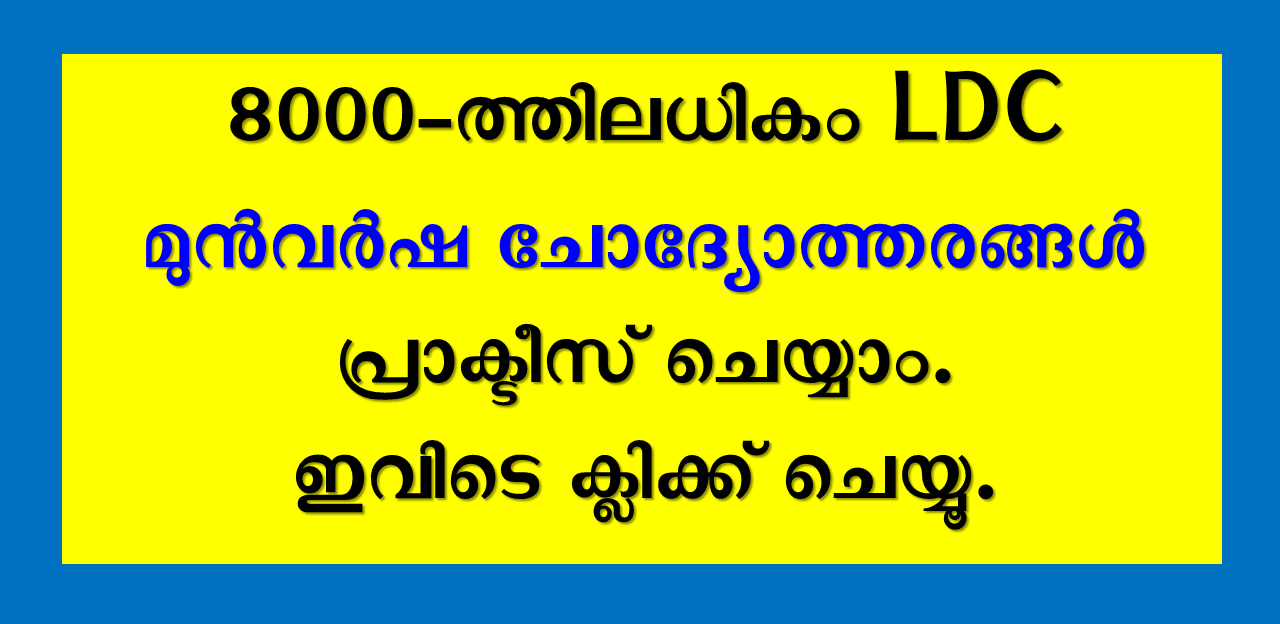PSC Secretariat Assistant/Auditor Model Questions and Answers – Part 2
26. Who was the first propounder of the doctrine of ‘Passive Resistance’?
(A) B.G. Thilak (B) Aurobindo Ghosh
(C) G.K. Gokhalae (D) M.K. Gandhi
Answer: D
27. In which Five Year Plan University Gants Commission was set up for promoting and strengthening higher education?
(A) First Five Year Plan
(B) Third Five Year Plan
(C) Fifth Five Year Plan
(D) Eleventh Five Year Plan
Answer: A
28. Who is known as the father of Renaissance of Western India?
(A) B.M. Malabari (B) M.G. Ranade
(C) R.G. Bhandarkar (D) K.T. Telang
Answer: B
29. The longest river of Peninsular India:
(A) Godavari (B) Krishna
(C) Kaveri (D) Mahanadi
Answer: A
30. The largest producer of rice in India:
(A) Kerala (B) Andhra Pradesh
(C) Tamil Nadu (D) Gujarat
Answer: West Bengal
31. The national animal of Kerala:
(A) Tiger (B) Elephant
(C) Leopard (D) Deer
Answer: B
32. The southern most river in Kerala:
(A) Kallada (B) Karamanayar
(C) Ithikkara (D) Neyyar
Answer: D
33. The largest National Park in Kerala:
(A) Eravikulam (B) Silent Valley
(C) Pambadum chola (D) Mathikettan chola
Answer: A
34. The first dam in Kerala:
(A) Malampuzha (B) Mullapperiyar
(C) Sabarigiri (D) Peechi
Answer: B
35. The most populated district in Kerala as per 2001 census:
(A) Thiruvananthapuram (B) Ernakulam
(C) Malappuram (D) Thrissur
Answer: C
36. Chattampi Swamikal was born in the year:
(A) 1851 (B) 1853
(C) 1854 (D) 1856
Answer: B
37. The ‘Savarna Jatha’, to support the Vaikom Satyagraha was organised by:
(A) Mannath Padmanabhan (B) T.K. Madhavan
(C) K. Kelappan (D) Dr. Palpu
Answer: A
38. ‘Vivekodayam’ magazine was published by:
(A) Ramakrishna Pillai (B) Pandit Karuppan
(C) V.T. Bhattathirippad (D) Kumaranasan
Answer: D
39. ‘Atma Vidhya Sangham’ was founded by:
(A) Ayyan Kali (B) Thycaud Ayya
(C) Vagbhatananda (D) Sahodaran Ayyappan
Answer: C
40. In Travancore, the Temple Entry Proclamation was made in:
(A) 1931 (B) 1936
(C) 1938 (D) 1940
Answer: B
41. The constitution describes India as a ……………
(A) Federal State (B) Quasi-Federal State
(C) Unitary State (D) Union of States
Answer: D
42. The authority/body competent to determine the conditions of citizenship in India:
(A) The President (B) The Parliament
(C) The Union Cabinet (D) The Supreme Court
Answer: B
43. From which constitution India borrowed the idea of Directive Principles of State Policy?
(A) Constitution of U.K.
(B) Constitution of the U.S.A.
(C) Constitution of Ireland
(D) Constitution of Canada
Answer: C
44. Who was the Chairman of the Constituent Assembly of India?
(A) Dr. B.R. Ambedkar (B) Dr. B.N. Rao
(C) Dr. Rajendra Prasad (D) Jawaharlal Nehru
Answer: C
45. Power of the Judiciary to declare a law invalid on constitutional ground is called:
(A) Judicial Activism (B) Judicial Review
(C) Judicial Supremacy (D) Judicial Absolutism
Answer: B
46. Status of Union Public Service Commission is ……………
(A) Legal (B) Administrative
(C) Advisory (D) Constitutional
Answer: D
47. Chairman of the National Human Rights Commission is appointed by …………..
(A) The President
(B) The Prime Minister
(C) The Chief Justice of India
(D) The Speaker of Loksabha
Answer: A
48. Money bill of the Union Government is first introduced in:
(A) Rajyasabha
(B) Loksabha
(C) Either in Rajyasabha or Loksabha
(D) In the joint sitting of Rajyasabha and Loksabha
Answer: B
49. Which amendment Act incorporated the Right to Education into the list of Fundamental Rights in India?
(A) 67th Amendment Act, 1990
(B) 68th Amendment Act, 1991
(C) 76th Amendment Act, 1994
(D) 86th Amendment Act, 2002
Answer: D
50. First Chairperson of the National Commission for Women:
(A) Jayanti Patnaik (B) Dr. V. Mohini Giri
(C) Dr. Poornima Advani (D) Mamta Sharma
Answer: A




